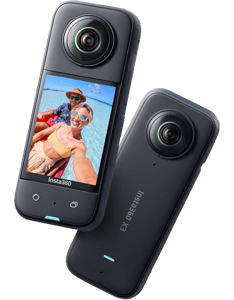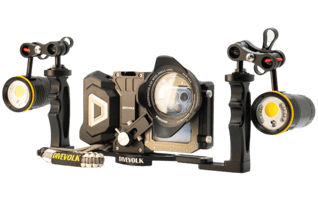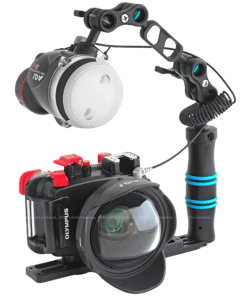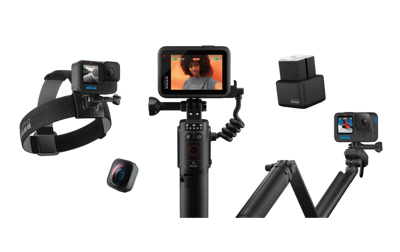Capture the Dive
Finding the Right Camera for Your Underwater Adventures
This blog contains affiliate links, which means I may earn a commission if you make a purchase through them at no extra cost to you. I only recommend products that I genuinely believe will add value to your experience. Thank you for your support!


During our dives, we all hope to encounter those breathtaking moments—the kind that take your breath away, even if they’re never guaranteed. And when they do happen, they’re often fleeting, lasting just a few minutes or even seconds, like flashes before your eyes. Naturally, most of us want to capture these moments, whether in photos or videos, so we can relive them later. Maybe it’s for those quiet days at home, flipping through memories, or even to print and hang on the walls as little reminders of the adventures we’ve had.
On my last dive, I felt like a kid let loose at a toy expo. I was testing out different cameras, asking for opinions, and trying to understand the differences from other divers' experiences. After soaking in all that information, I thought, why not break it down for you guys?
Photo vs. Video: What’s Your Focus?
First off, let’s talk about the two main types of divers when it comes to capturing moments—those who love taking photos and those who are all about recording videos. Sure, some cameras can do both, but let’s be real: no camera is perfect at everything. Each one has its strengths and weaknesses, depending on what you’re looking for.
So, let’s break it down. I’ll cover a few popular brands, highlight what they’re good at, and share some insights from user experiences. Of course, I’ll also throw in a recommendation for one of their standout products. To make things even easier, there’s a handy chart comparison at the end to help you figure out which camera suits your style and needs best.
Ready? Let’s dive into the details!
OM System: Rugged Macro Master
Pros: Rugged and durable; exceptional for macro shots; user-friendly.
Cons: Requires housing for deeper dives (beyond 15m), adding bulk.
Recommended Product: OM System Tough TG-7 [Amazon]
I’ve personally had the chance to try out the OM System Tough TG-6, and let me tell you—it’s incredible for macro photography. If you’re into capturing the tiniest underwater creatures in stunning detail, this is the one for you. But for me... well, it’s a bit of a mixed bag.
The camera itself isn’t heavy, but you’ll likely need a housing if you’re diving beyond its depth limits, and that can add some bulk. So, if you’re like me and prefer shooting videos or snapping pictures of larger marine animals, lugging it around for the whole dive might not be ideal. It’s definitely worth considering how much you value those up-close macro shots versus the convenience of lighter gear.






Comparison Chart
Insta360: Immersive 360° Perspectives
Pros: Unique 360° video capabilities; compact design; flexible editing options.
Cons: Requires housing; editing 360° footage can be challenging for beginners; less suited for still photography.
Recommended Product: Insta360 X3 [Insta360] (using this link to purchase an Insta360 will also get you free accessories directly from Insta360)
A lot of my friends have started switching from GoPro to Insta360. Not because there’s anything wrong with GoPro—it’s still a solid choice—but that unique 360° capability is a big draw. Plus, Insta360 offers some pretty flexible editing options, which makes it stand out.
Of course, there’s a catch: the editing part can be a bit tricky, especially if you’re new to working with 360° footage. But once you get the hang of it, the results can be incredible. If you’re up for a bit of a learning curve, Insta360 is definitely worth considering. It’s not just a tool—it’s a lot of fun to play around with too.
GoPro: The Action Video King
Pros: Industry leader; excellent video stabilization; great for wide-angle shots; versatile accessories.
Cons: Photo quality isn’t as strong; battery life can be short; housing needed for deeper dives.
Recommended Product: GoPro HERO12 Black [Amazon]
GoPro is an industry-leading brand for a reason. The video quality is excellent, and it’s a go-to choice for so many divers. However, I’ll admit that when I last used one (a while back), the touchscreen left a lot to be desired—it wasn’t the most responsive.
With the HERO12, though, users have been raving about the improvements in touchscreen responsiveness. That’s definitely something to keep in mind. If you’re curious, I’d suggest trying it out first if one of your fellow divers has one. Borrow it for a bit, play around with it, and see if it fits your needs. It’s always good to test things out before you commit, right?
DiveVolk: Smartphone Simplicity
Pros: Affordable; uses your smartphone’s camera; lightweight with full touchscreen functionality underwater.
Cons: Relies on your phone's camera quality; prone to overheating and quick battery drainage.
Recommended Product: DiveVolk SeaTouch 4 Max [Amazon]
DiveVolk was actually the first of the four brands I tried, mainly because it’s what my girlfriend uses. Right away, I could see why she likes it—it’s super easy to assemble and clean, which is always a plus.
The setup is straightforward, and since it uses your smartphone, there’s no need for additional bulky equipment. But here’s the catch: everything depends on your phone’s camera quality. If you’re planning to record an entire dive, you might run into issues with your phone heating up or the battery draining faster than expected.
That said, if you’re only planning to capture highlights or specific moments, it’s still a solid option. Lightweight, convenient, and simple—it checks a lot of boxes, especially for casual divers.


With this chart, I hope you’ll have an easier time deciding which brand or product suits you best to capture your unique diving experiences. Each of these four brands brings something special to the table, so it all comes down to your preferences and how you want to relive those underwater moments.
My Picks for Different Needs
Photography: If you love capturing vivid details of marine life, the OM System Tough TG-7 is your best bet.
Videos: For smooth and stabilized underwater videos, the GoPro HERO12 Black is a no-brainer.
Fun & Creativity: If you want to experiment with unique perspectives, Insta360 X3 is perfect for its immersive 360° capabilities.
Convenience: DiveVolk SeaTouch 4 Max is a great option for lightweight, budget-friendly flexibility, especially for casual divers.
Personal Favorites
Personally, I lean slightly more toward video over photos, and I love both GoPro and Insta360 for that. GoPro is my go-to for recording entire dives—it’s reliable and consistent. But Insta360 is perfect for those unique moments or even capturing the scenery before a dive. Just imagine having a stunning 360° view of your dive site—it’s almost guaranteed to be breathtaking!
When it comes to photos, my choice is DiveVolk. I prefer taking shots of larger marine animals, so carrying a TG all day just isn’t practical for me. It’s an incredible camera, but I’d rather keep things lightweight and focus on capturing the big moments.
At the end of the day, the best choice is the one that aligns with how you want to relive and share your adventures. Let me know which one works best for you—or if there’s another brand or gear you think deserves a mention!
Let’s Dive In
I hope this guide helps you decide which underwater camera suits your needs best. If you’ve tried these products or have recommendations for other brands, let me know in the comments! Let’s share our experiences and make our underwater adventures even more unforgettable.
As mentioned at the beginning of this post, some links may be affiliate links.
Explore
Celebrate coastal artistry and embrace the journey toward sustainable living
Crafted
CONTACT US
© 2025 Current Journeys. All Rights Reserved. The designs, images, and content on this website are the exclusive property of Current Journeys and may not be reproduced or used without written permission.
Return & Refund Policy
Inspired
